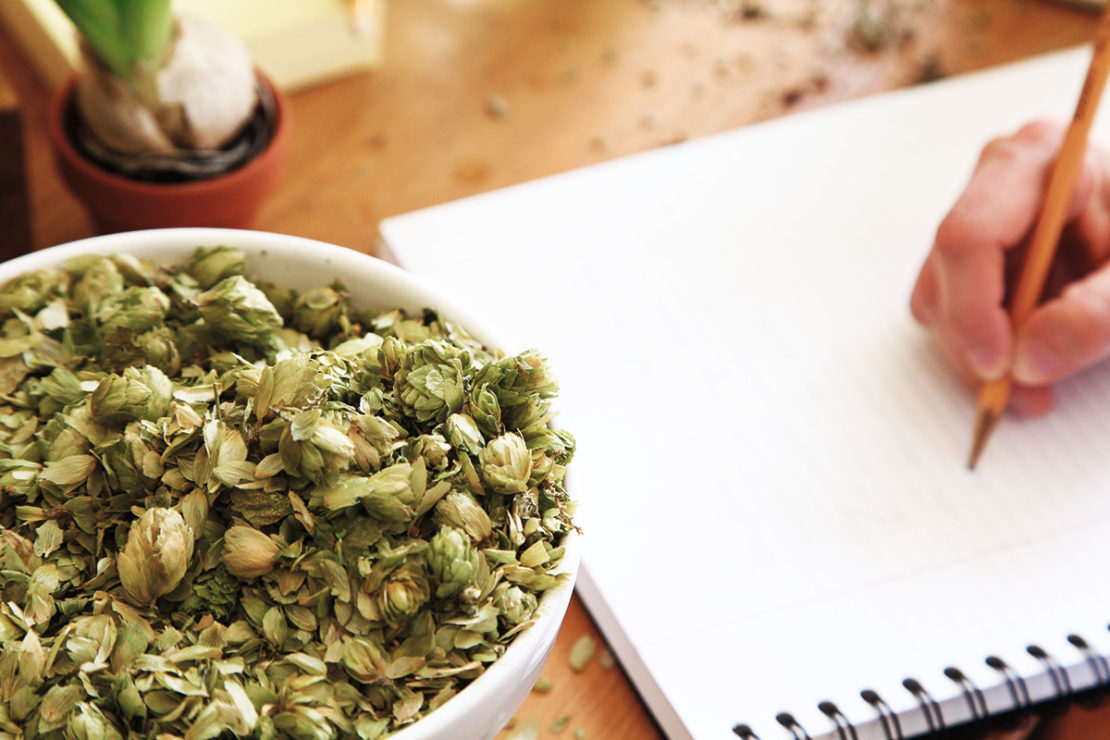
The Lure and Lore of HOPS: The 2018 Herb of the Year
Each year since 1995, the International Herb Association picks an Herb of the Year. This year that herb is hops (Humulus spp.).
Below you’ll find information about cultivating and harvesting hops as well as some interesting lure and lore about this year’s Herb of the Year.
All About Hops
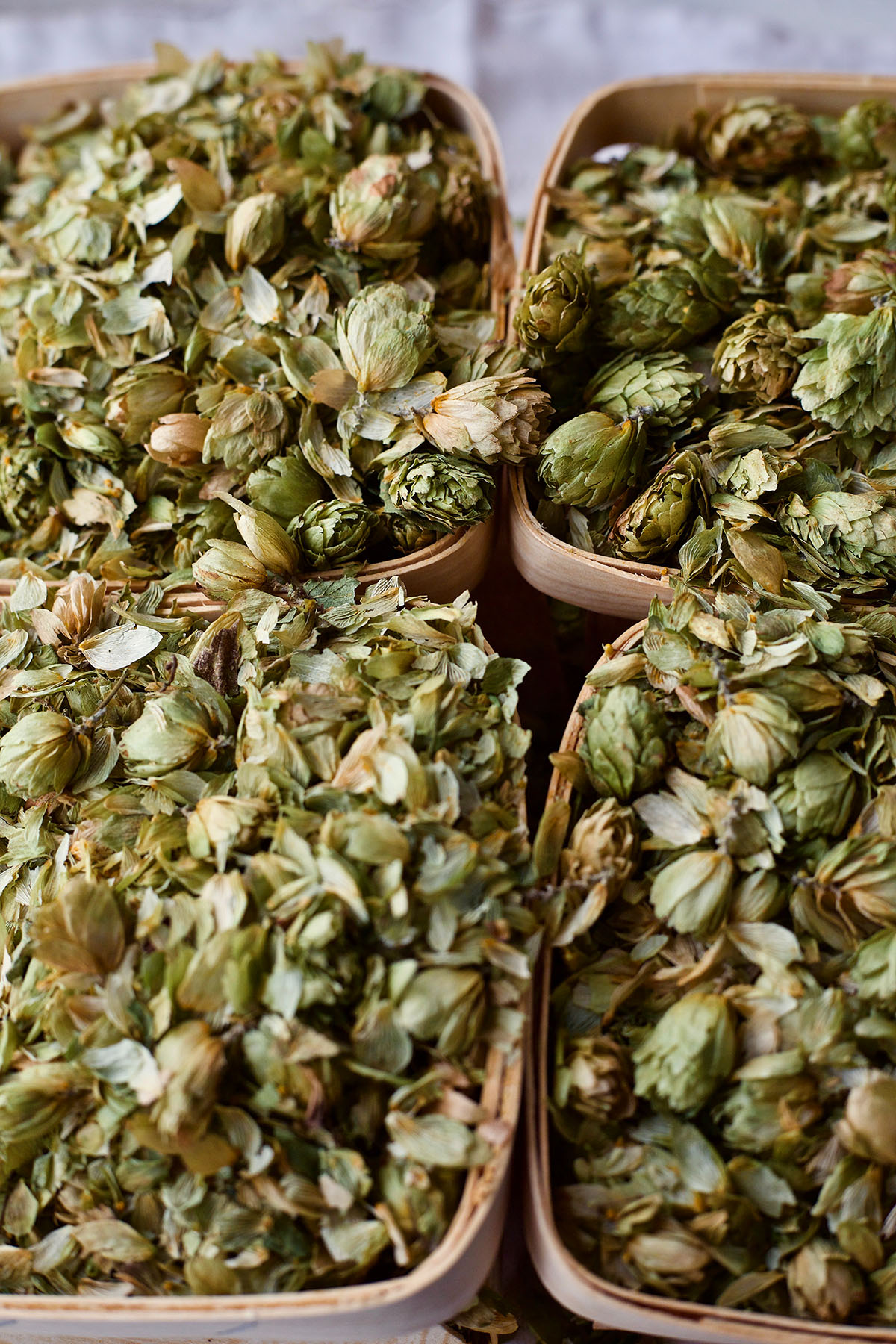
Hops is a member of the Cannabaceae family. Other family members include hemp and cannabis.
The most commonly used species of hops is Humulus lupulus. The name lupulus comes from “lupus” or “wolf” due to the Romans’ incorrect belief that it strangles the plants around it as a wolf does with its prey. Hops come from the Anglo-Saxon word hoppan which means “to climb,” as the bine will assuredly climb on anything that gets in its way!
Some sources claim hops is native to Britain, but others indicate that native species are found in Britain, Europe, Asia, and North America.
Cultivation
Hops is a perennial plant that dies back each fall and returns in the spring. It prefers full sun and a south or southwestern exposure but can survive in partial shade. Hops plants like nitrogen so it’s a good idea to add manure or compost to the soil around them now and then. A friend who grows hops told me they felt it was best grown around the 48th parallel.
The hops plant is a bine (not vine) that can easily grow 30 feet high and can be quite invasive. When deciding to grow hops, find the right place and give it something to climb up, or it may grow right over other plants and even creep across your driveway!
Hops are dioecious, meaning they have both male and female plants which produce flowers; however, the flowering hop, or strobile, is cultivated using the female plants only to avoid production of the fruit, which is not of commercial value (Koetter & Bendl, 2010). The strobile can be up to an inch and a half long, is green in color, and is covered with bracts which look a bit like scales. The female flower produces lupulin, a yellow powdery substance you see between the bracts, as it ripens. This is very sticky and is what gives hops its very distinct aroma. The leaves are heart-shaped or deeply lobed with three to five lobes and are arranged opposite to one another until towards the end of the bine where they can become alternate.
Propagation is best from root division in early spring or cuttings that have been taken in late spring. Seed germination is erratic and may produce wild hops. I have found the best way to plant hops is in a hill with three plants about 18 inches apart.
Hops are host to several diseases, including downy mildew. I was told by a hops grower that the mildew can survive the winter if it gets in the crown of the plant. If this happens, the entire plant should be removed and burned to keep it from spreading. In cool weather, aphids and spider mites can become a problem.
Harvesting Hops
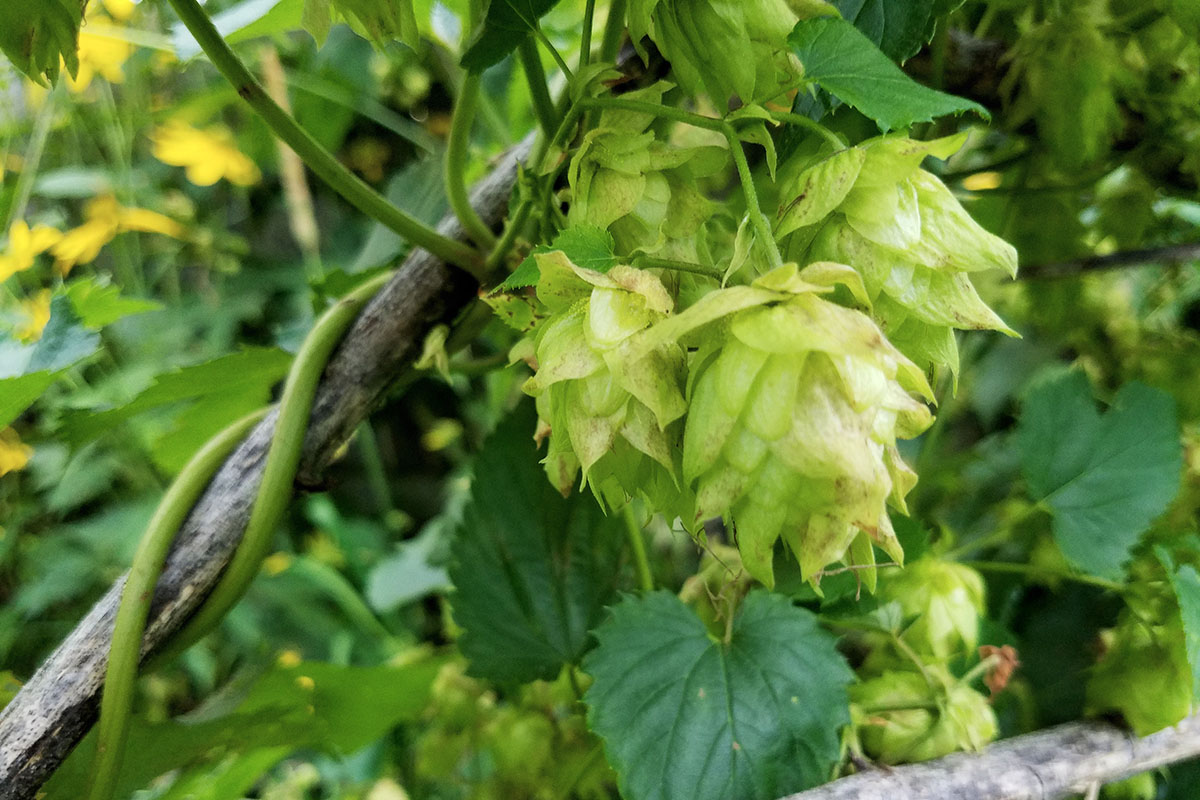
Harvesting occurs in fall when the strobiles turn an amber or golden color. The easiest way I’ve found to harvest hops is to throw sheets down under the bines and clip the bines and strobiles letting them fall on the sheets. Be sure to dry the strobiles quickly, and store them as soon as they are dry to prevent them from becoming too bitter. Also know that when harvesting or working with hops, the yellow powdery lupulin is very sticky. It will get on your hands and can be very difficult to remove, so gloves are a must.
An interesting note about harvesting hops is that in production when women hand-harvest hops, they will often start their menses shortly after picking the strobiles (Kane, 2009). Harvesting over a long time span has resulted in synchronization of the women pickers’ menstrual cycles.
Energetics of Hops
- Flavor: Bitter
- Temperature: Cold
- Moisture: Dry
- Polarity: Yang
- Element: Air
(Mars, 2016)
Safety
Hops is generally considered safe, however, it should not be used by pregnant women or women who have had or have estrogen-related breast cancer. It should not be used for kids under two. Older kids and elders over 65 should use with caution and under their healthcare professional’s supervision. It should not be used by those suffering from depression as it could accentuate this condition. I have seen it cause rashes in some people (Castleman 2917).
Uses for Hops
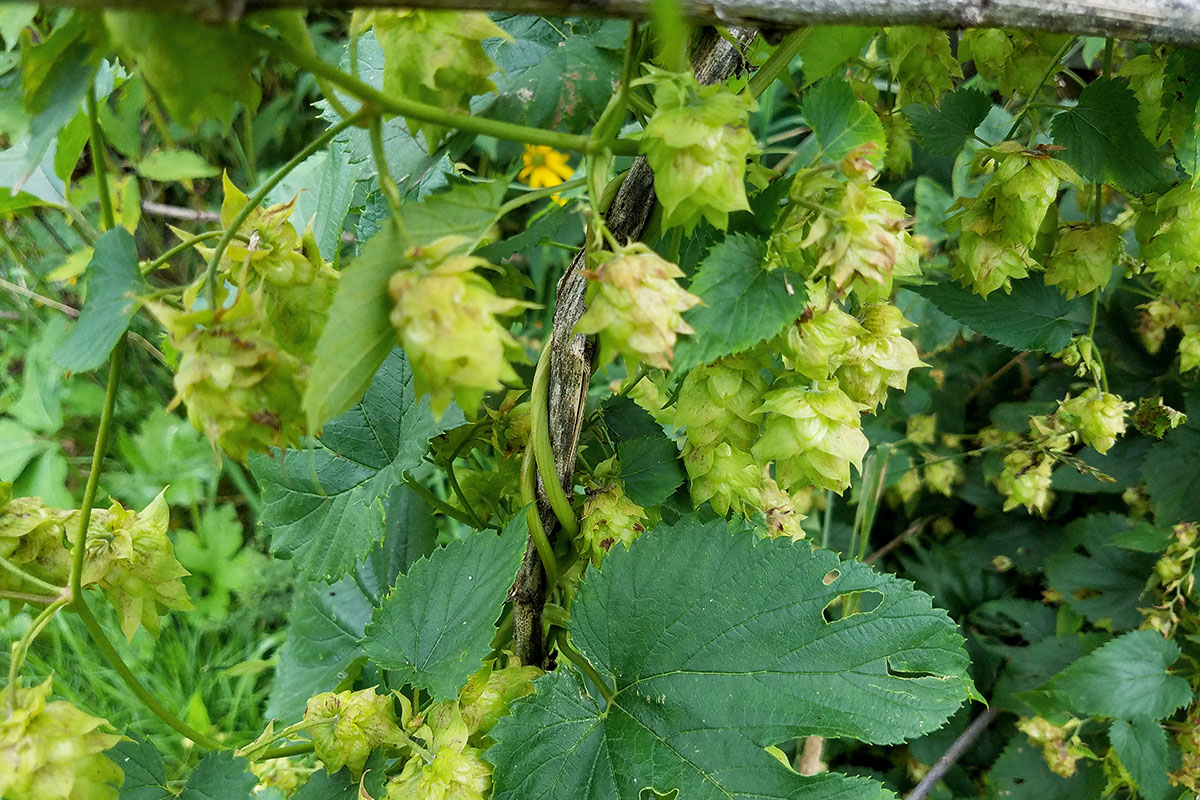
In the spring, the shoots of the hops plant have been used as an asparagus-like vegetable since Pliny’s (AD 23-79). In medieval times, hops were used as a bitter potherb. Young leaves were blanched and added to soups (Bremness, 1994).
Of course, beer is the use most of us associate with hops as they have been used in brews for more than 1,000 years. In fact, it’s thought that the Netherlands may have been the first to brew with hops.
Some other uses of hops include:
- King George III was a noted insomniac, and legend has it that he had his mattresses filled with hops to ensure a good night’s sleep. Abraham Lincoln was said to have used a pillow filled with hops to help him sleep. (Fast forward to the 21st century, and we add hops to our “dream or sleep pillows” to help with sleeping.)
- The leaves yield a brown dye and the stems have been used in the weaving of baskets.
- Cosmetically, hops has been used in creams to soften the skin and as a hair conditioner.
- Medicinally, hops were used externally for boils, toothaches, and skin problems. It is still used by some herbalists in poultice form as an anti-inflammatory for arthritis and sore joints (Rodale, 1998).
- It is touted as a digestive aid, and also used for stress and tension.
- It can be tinctured and blends well with a valerian for a sleep aid. You can also use it to make your own sleep pillow.
- Due to its fibrous stems, it has been used to make a coarse cloth, rope, and paper.
- A muslin bag filled with hops held against the ear may help with ear pain.
With so many uses, both from old times and from now, hops should be on your list of new plants to grow for 2018. I hope you have been encouraged to try this fabulous herb!
Free Hops Monograph Flyer Download
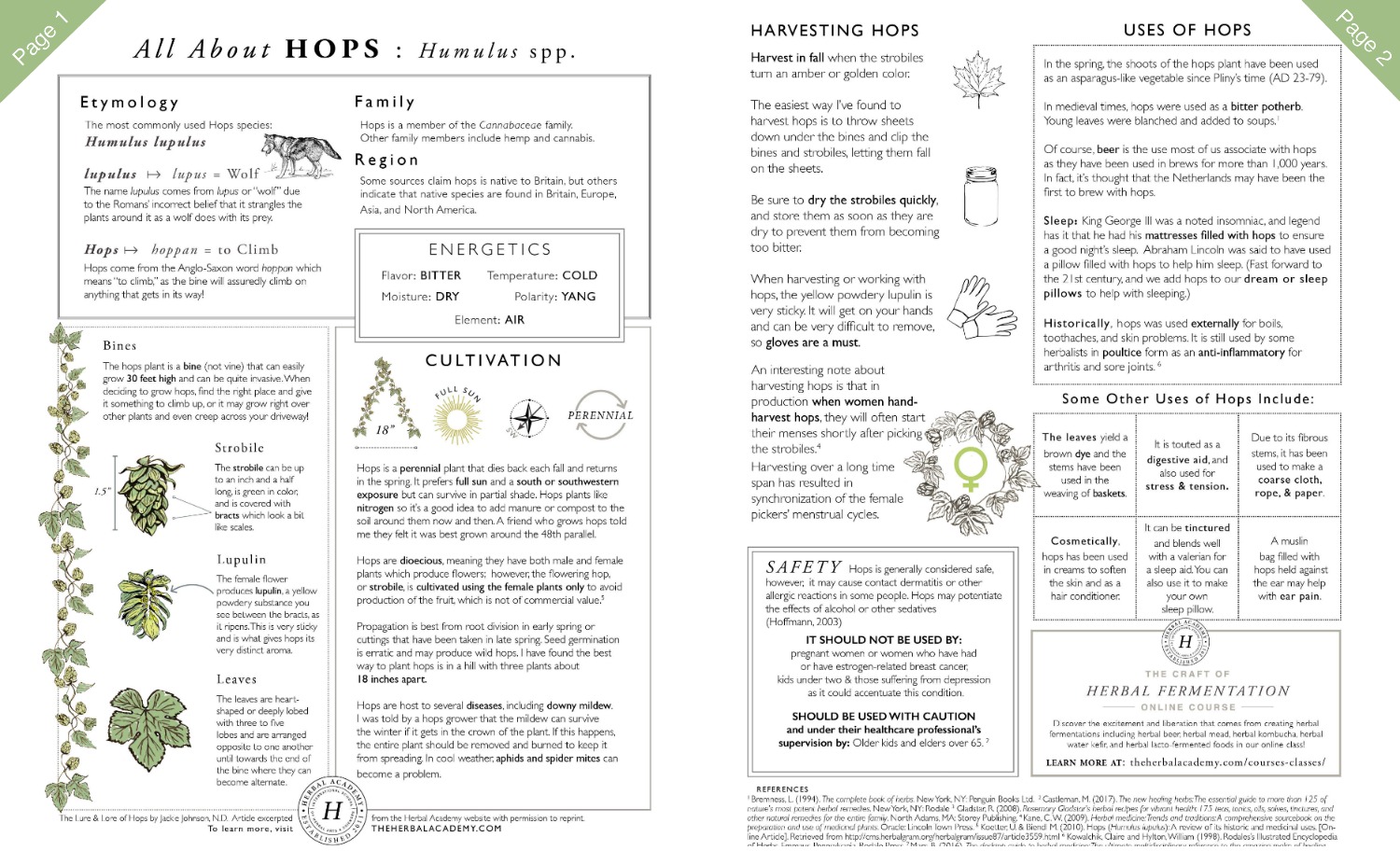 If you’ve enjoyed learning more about hops, we’ve created a free Hops Monograph Flyer download filled with all the things you will want and need to know about this lovely plant. Just click “download” below, save this file to your computer or print it off to store it in your herbal materia medica!
If you’ve enjoyed learning more about hops, we’ve created a free Hops Monograph Flyer download filled with all the things you will want and need to know about this lovely plant. Just click “download” below, save this file to your computer or print it off to store it in your herbal materia medica!
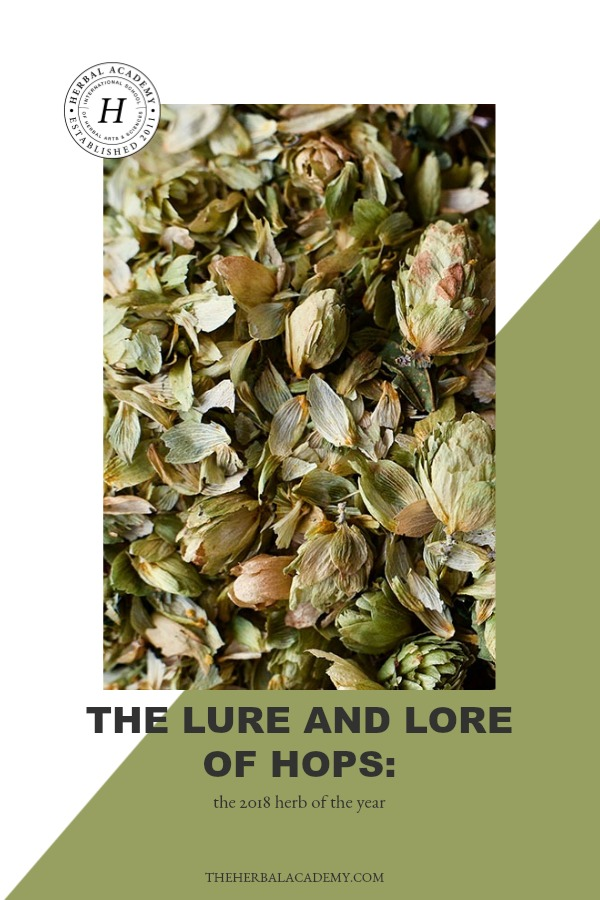
REFERENCES
Bremness, L. (1994). The complete book of herbs. New York, NY: Penguin Books Ltd.
Castleman, M. (2017). The new healing herbs: The essential guide to more than 125 of nature’s most potent herbal remedies. New York, NY: Rodale.
Gladstar, R. (2008). Rosemary Gladstar’s herbal recipes for vibrant health: 175 teas, tonics, oils, salves, tinctures, and other natural remedies for the entire family. North Adams, MA: Storey Publishing.
Kane, C. W. (2009). Herbal medicine: Trends and traditions: A comprehensive sourcebook on the preparation and use of medicinal plants. Oracle: Lincoln Town Press.
Koetter, U. & Biendl M. (2010). Hops (Humulus lupulus): A review of its historic and medicinal uses. [Online Article]. Retrieved from http://cms.herbalgram.org/herbalgram/issue87/article3559.html
Kowalchik, Claire and Hylton, William (1998). Rodales’s Illustrated Encyclopedia of Herbs. Emmaus, Pennsylvania, Rodale Press.
Mars, B. (2016). The desktop guide to herbal medicine: The ultimate multidisciplinary reference to the amazing realm of healing plants, in a quick-study, one-stop guide. Columbus, OH: Basic Health Publications, Inc.







